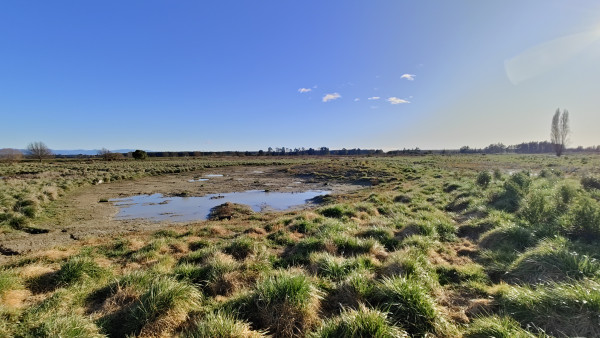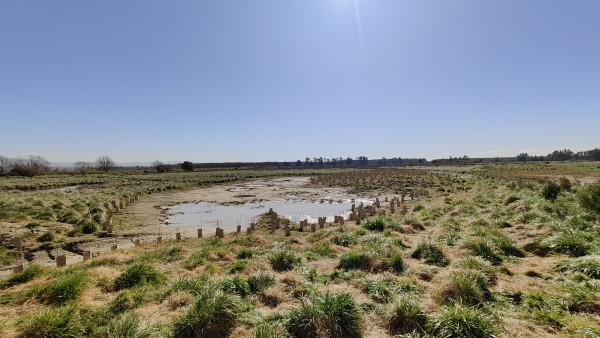The Waimea Delta provides a unique opportunity for restoring marshbird habitat, hopefully drawing back the nationally critically, and extremely shy, matuku or Australasian bittern, among other rare and important taonga species.
The combination of freshwater and saltwater habitat creates a rich smorgasbord of food sources for native wildlife. The Waimea Delta is one of very few areas in Tasman District in public ownership that is large enough to successfully recreate this important wetland environment.
A three-year project jointly funded by Tasman District Council and Ministry for the Environment will widen former channels of the Waimea River and create ponds, islands and micro-bays to form a mosaic of habitats. The team will plant wetland vegetation, native trees and grasses to facilitate nutrient uptake, shading of watercourses and increased biodiversity by creating corridors to link habitats.
Work began in March 2022. The philosophy guiding the project is to carry out small, staged periods of earthworks. This reduces the disruption to the site and potential sedimentation. It will allow the project to assess the impacts of each portion of work and the effects of flooding – a common, natural event on this site – learning and adjusting the programme of work along the way.
Thanks to the Department of Conservation (NZ) for the recording of matuku booming, heard at the start of this video.
Learn more about matuku
Australasian bittern/matuku: Wetland birds(external link)
Learn more about our other work in the Waimea Inlet
Waimea Inlet Management Strategy
New drone imagery shows the progress of our Waimea Delta wetland enhancement project over the past two and a half years.
This multi-stage project is designed to enhance the ecological value of Waimea Delta and encompasses brackish wetland areas in a low-lying arm of the Waimea River, just east of Pearl Creek.
The site is adjacent to salt marsh and downstream from the cycle bridge along Tasman’s Great Taste Trail.
The extent of the progress in all its glory is not entirely visible from the trail at first glance. However, there’s been a heap of work put into improvements around this area and so these comparisons are a great way to see how far we’ve come in the past couple of years.
Two phases of earthworks for wetland enhancement have been completed along with the planting of native trees and wetland plants, with great growth so far.
The aim is that the area will develop into even more of a haven for marsh birds like matuku (bittern) and mātātā (fernbird).
Pest control in surrounding areas is well underway, with significant work being done near the Waimea Delta, targeting species like Tamarisk, Old Man’s Beard and Japanese Honeysuckle.
Additionally in the Waimea Inlet, several large salt marsh planting projects are in the pipeline, including further restoration efforts at Rough Island where culverts were installed for greater saltwater inundation.
These projects have been made possible by funding from the Ministry for the Environment and Tasman District Council through the Jobs for Nature – Mahi mō te Taiao scheme.
Battle for the Banded Rail volunteers turned out in force for a Sunday planting in which over 1,100 natives were planted at the Waimea Delta wetland enhancement area.


These before and after photos show how the extent of the work - we're excited to see the plants grow and support the environment in the future.
Contractors will put in a further 4300 plants in the next few weeks/months too.
The Waimea Delta continues to look a little more revitalised as progress on re-establishing wetlands in this special part of the region moves forward.
Following initial work done in March 2022, we’ve recently finished the second phase of earthworks at the site, an impressive effort that has set the foundation for further biodiversity gains in the area.
The Waimea Delta is one of the very few areas in Tasman District in public ownership that is large enough to successfully recreate this important wetland environment.
The second phase of the project was designed to further improve the biodiversity of the site by creating more varied habitats as well as adding woody debris (root wads) to create fish shelter.
To achieve this, the project team undertook earthworks to further expand low-lying areas and create mounds of varying heights and sizes throughout the wetland.
These structures were strategically placed to create areas of varying moisture levels, which are ideal for different plant and animal species – specifically marsh birds like the Matuku (Australasian Bittern).
There will be further wetland, terrestrial and salt marsh planting done this winter and spring.
Next time you are on Tasman’s Great Taste Trail on the way to Moturoa / Rabbit Island, make sure you stop for a look.
There’s been some amazing progress on our Waimea Delta wetlands enhancement project in 2022. Check out this video to see the changes.
Over the next two years, the area will see further targeted earthworks, weed control and planting to enhance the diversity in the area with the aim of creating a rich habitat for rare marshland birds including the critically endangered matuku (Australasian bittern).
A carefully-managed reset of the landscape at the start of the year has since allowed us to add some new plant life which, as the images show, has already made a significant impact.
The first stage of this wetland creation project, designed to enhance the ecological value of Waimea Delta, began with earthworks in March.
Initial work focused on creating open water areas alongside the existing channel to increase the area of open water.
Terrestrial planting around the area occurred over winter, followed by further wetland planting in spring.
We were fortunate that the area and our work was not adversely affected by recent weather events.
Around 2000 more wetland plants are due to be planted in late October.
As well as creating a thriving wetland, we want to ensure the Waimea Delta is a safe environment for the wildlife making a habitat there.
With this in mind, predator control is also ongoing with the support and mahi of Tasman Environmental Trust/ Battle of the Banded Rail Trust volunteers.
Phase two will take place in early 2023. The broader work plan includes widening channels and creating new swamps and marsh to create diverse wildlife habitats and enhance habitat connectivity.
The project has been made possible by funding from the Ministry for the Environment and Tasman District Council through the Jobs for Nature - Mahi mō te Taiao scheme.
Last modified: